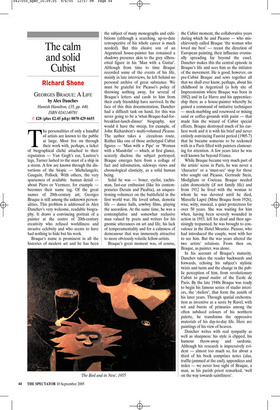The calm and solid Cubist
Richard Shone
GEORGES BRAQUE: A LIFE by Alex Danchev Hamish Hamilton, £35, pp. 440, ISBN 0241140781 ✆ £28 (plus £2.45 p&p) 0870 429 6655 The personalities of only a handful of artists are known to the public at large. Most live on through their work with, perhaps, a ticket of biographical cliché attached to their reputation — Van Gogh’s ear, Lautrec’s legs, Turner lashed to the mast of a ship in a storm. A few are known through the distortions of the biopic — Michelangelo, Gauguin, Pollock. With others, the very sparseness of available human detail about Piero or Vermeer, for example becomes their name tag. Of the great names of 20th-century art, Georges Braque is still among the unknown personalities. This problem is addressed in Alex Danchev’s very welcome, readable biography. It draws a convincing portrait of a painter at the centre of 20th-century creativity who refused worldliness and invasive celebrity and who seems to have had nothing to hide but his work.
Braque’s name is prominent in all the histories of modern art and he has been the subject of many monographs and exhibitions (although a searching, up-to-date retrospective of his whole career is much needed). But this elusive son of an Argenteuil house-painter has remained a shadowy presence akin to the grey silhouetted figure in his ‘Man with a Guitar’. Although from time to time Braque recorded some of the events of his life, mainly in late interviews, he left behind no personal archive of great substance. We must be grateful for Picasso’s policy of throwing nothing away, for several of Braque’s letters and cards to him from their early friendship have survived. In the face of this thin documentation, Danchev had a difficult task on hand, for this was never going to be a ‘what-Braque-had-forbreakfast-lunch-dinner’ biography, nor would it have the sweep, for example, of John Richardson’s multi-volumed Picasso. The author takes a circuitous route. Rather like one of those archetypal Cubist figures — ‘Man with a Pipe’ or ‘Woman with a Mandolin’ — which, at first glance, scarcely disclose the subject portrayed, Braque emerges here from a collage of fact and information, sideways views and chronological elasticity, as a solid human being.
Solid he was — boxer, cyclist, yachtsman, fast-car enthusiast (like his contemporaries Derain and Picabia), an unquestioning volunteer on the battlefield in the first world war. He loved urban, demotic life — dance halls, cowboy films, playing the accordion. At the same time, he was a contemplative and somewhat reclusive man valued by poets and writers for his gnomic utterances on art and life, his lack of temperamentality and for a calmness of demeanour that was immensely attractive to more obviously volatile fellow-artists.
Braque’s great moment was, of course, the Cubist moment, the collaborative years during which he and Picasso — who mischievously called Braque ‘the woman who loved me best’ — recast the direction of European painting, their influence eventually spreading far beyond the easel. Danchev makes this the central episode in Braque’s life and sees him as the initiator of the movement. He is good, however, on pre-Cubist Braque and sews together all that we shall ever know, perhaps, about his childhood in Argenteuil (a holy site of Impressionism where Braque was born in 1882) and in Le Havre and his apprenticeship there as a house-painter whereby he gained a command of imitative techniques — mock-marbling and rosewood or mixing sand or coffee-grounds with paint — that made him the wizard of Cubist special effects. Braque destroyed much of his earliest work and it is with his brief and never entirely convincing Fauvist period (1905-7) that he became someone to be reckoned with in a Paris filled with painters clamouring for attention. A few years later he was well known far beyond France.
While Braque became very much part of the artists’ scene in Paris, he was never a ‘character’ or a ‘must-see’ stop for those who sought out Picasso, Gertrude Stein, Modigliani or Cocteau. Braque needed calm domesticity (if not family life) and from 1912 he lived with the woman to whom he was devoted until he died, Marcelle Lapré (Mme Braque from 1926), wise, witty, musical, a quiet protectress for over 50 years. She was waiting for him when, having been severely wounded in action in 1915, left for dead and then agonisingly trepanned, he was brought to convalesce in the Hotel Meurice. Picasso, who had introduced the couple, went with her to see him. But the war years altered the two artists’ relations. From then on, Braque, as painter, was alone.
In his account of Braque’s maturity, Danchev takes the reader backwards and forwards, echoing his subject’s stylistic twists and turns and the change in the public perception of him, from revolutionary Cubist to grand maître of the Ecole de Paris. By the late 1940s Braque was ready to begin his famous series of studio interiors, the ‘Ateliers’, that form the zenith of his later years. Through spatial orchestration as inventive as a score by Ravel, with wit and bursts of primaries among the often subdued colours of his northern palette, he transforms the oppressive materials of his day-to-day life. Here are paintings of his view of heaven.
Danchev writes with real sympathy as well as sharpness: his style is clipped, his humour throw-away and sardonic. Although his research is impressively evident — almost too much so, for about a third of his book comprises notes (alas, traffic-jammed at the end), appendices and index — we never lose sight of Braque, a man, as his parish priest remarked, ‘well on the way towards saintliness’.
























































 Previous page
Previous page